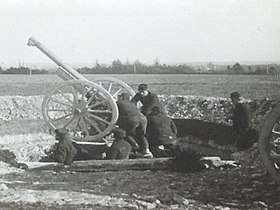7.7 cm FlaK L/35
| 7.7 cm FlaK L/35 | |
|---|---|
_(cropped).jpg) A Krupp 7.7 cm FlaK L/35 AA gun at the Musée Royal de l'Armée, Brussels. | |
| Type | Anti-aircraft gun |
| Place of origin |
|
| Service history | |
| In service | 1914–1918 |
| Used by |
|
| Wars | World War I |
| Production history | |
| Designer | Schneider et Cie |
| Designed | 1897 |
| Manufacturer | Krupp |
| Produced | 1914 |
| No. built | 394 |
| Specifications | |
| Weight |
Travel: 2,050 kg (4,520 lb) Combat: 1,250 kg (2,760 lb) |
| Barrel length | 2.7 m (8 ft 10 in) L/35[1] |
|
| |
| Shell | Fixed QF |
| Shell weight | 6.85 kg (15 lb 2 oz) |
| Breech | Nordenfelt eccentric screw |
| Recoil | Hydro-pneumatic |
| Carriage | Box trail |
| Elevation | +1° to +60°[1] |
| Traverse | 360° |
| Rate of fire | 12 rpm |
| Muzzle velocity | 487 m/s (1,600 ft/s) |
| Effective firing range |
Horizontal: 7.2 km (4.5 mi) Vertical: 4,000 m (13,000 ft)[1] |
| Wikimedia Commons has media related to 7.7 cm FlaK L/35. |
The 7.7 cm FlaK L/35 was a German 77 mm anti-aircraft gun produced by Krupp during the First World War.
History
The origins of the 7.7 cm FlaK L/35 go back to the French Canon de 75 modèle 1897 field gun which was captured in large numbers during the first two years of World War I. A combination of factors led the Germans to issue M1897's to their troops as replacements.
These included:
- An underestimation of light field artillery losses during the first two years of the war and an inadequate number of replacement guns being produced.
- An underestimation of ammunition consumption, inadequate production capacity, and resulting shortages.
- The superior ballistic performance of the M1897 compared to German designs.[1]
Once adequate numbers of new field guns such as the 7.7 cm FK 16 were being produced obsolete types such as the 9 cm Kanone C/73 and captured guns such as the M1897 and 76 mm divisional gun M1902 were withdrawn from front-line service and issued to anti-aircraft units. At first, all of the combatants employed field guns on improvised anti-aircraft mounts, which were typically earthen embankments or scaffolds to get the muzzle pointed skyward. Later in the war, specialized anti-aircraft mounts were developed.[1]
Design
The 7.7 cm Flak L/35 was a conversion of captured M1897's that were bored out to fire German 7.7 cm ammunition and placed on high angle mounts for the anti-aircraft role. When the barrels became worn out they were replaced with German made ones of the same length without the distinctive muzzle roller guides of the French gun.[2] The first of these conversions were from Krupp. It consisted of mounting bored out barrels on modified de Bange 120 or 155 carriages to allow up to 60° of elevation. In the field, the guns were anchored to a firing ring to allow 360° of traverse. By Spring of 1916, every division had a two gun platoon for AA defense and 394 guns were converted.[1]
Photo Gallery
 An improvised anti-aircraft mount with a mle 1897.
An improvised anti-aircraft mount with a mle 1897._(cropped).jpg) A damaged FlaK L/35 with replacement barrel captured by the allies on display.
A damaged FlaK L/35 with replacement barrel captured by the allies on display. A FlaK L/35 with original barrel on its firing ring.
A FlaK L/35 with original barrel on its firing ring. A FlaK L/35 battery in Palestine.
A FlaK L/35 battery in Palestine.